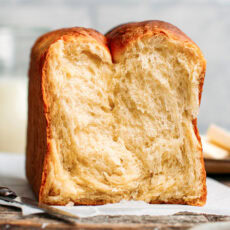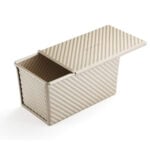

The Best Vegan Brioche
Introducing the best vegan brioche! Entirely plant-based, this brioche has a rich buttery aroma and the most incredible texture - it's light, stringy, and cottony! Plus, it is infused with a hint of orange blossom water and vanilla for delicate floral notes. You will never believe this brioche is eggless!
Ingredients
Yudane
- 100 g bread flour
- 100 g boiling water
Dough
- 100 ml unsweetened plant-based milk
- 30 ml orange blossom water
- 15 ml vanilla extract
- 5 g instant yeast
- 320 g bread flour
- 60 g sugar
- a pinch of vitamin C about 1/32 teaspoon or the tip of a knife
- 6 g salt
- 170 g vegan butter diced and softened
Instructions
Yudane
- Mix the water with the flour. Start by adding the flour to a mixing bowl. Next, bring the water to a boil and pour it into the bowl containing the flour. Using a wooden spoon, mix the flour with the water until it forms a thick paste.
- Cover and refrigerate. Cover with plastic wrap and refrigerate for at least 5 hours, preferably overnight.
Dough
- Once the Yudane has rested long enough, you can prepare the brioche dough.
- Add the wet ingredients to a stand mixer. To the bowl of a stand mixer, add the plant-based milk, orange blossom water, and vanilla extract.
- Add the dry ingredients. Then, add the instant yeast, bread flour, sugar, vitamin C powder, and Yudane. Note: Do not add the salt yet as it could kill the yeast. We will add the salt a bit later.
- Knead on low speed. Using the dough hook attachment, knead the dough on speed 2 for 5-7 minutes. At this point, the dough will still have a slightly grainy texture.
- Knead on medium speed. Add the salt and knead on speed 4-5 for about 20 minutes or until the dough passes the windowpane test. The dough should be very smooth and stretchy. Do not add more flour, the dough is supposed to be soft and sticky.
- How to do the windowpane test: Take a small ball of dough, flatten it, and stretch it into a rectangle between your hands. As you stretch it, the dough should become very thin, almost see-through, and should not break easily. That means the gluten network is strong enough. On the opposite, if the dough is not elastic enough and you cannot stretch it into a thin layer, it means you must knead it for a longer period of time.
- Slowly add the butter. Once your dough has passed the windowpane test, it’s time to incorporate the butter. As the stand mixer runs on speed 4-5, slowly add the diced butter. I recommend adding just a few cubes of butter at a time and adding more once it is fully incorporated. It should take about 5 minutes for all of the butter to be fully incorporated into the dough.
- First rise. Transfer the dough to a mixing bowl and cover it with plastic wrap touching the dough. This will prevent it from forming a crust. Let the dough rise in a warm place for about 45 minutes.
- Second rise. Next, punch the dough to deflate it and cover it with plastic wrap again. Allow it to rise slowly in the refrigerator for at least 4 hours, preferably overnight. This will allow the flour to absorb the butter, resulting in a better flavor.
- Prepare a loaf pan. Lightly grease and line a 1-pound Pullman loaf pan with parchment paper.
- Divide the dough into balls. Take the dough out of the refrigerator and punch it to release the air. Divide it into 6 even balls. I recommend weighing the dough and dividing it by 6 to make sure each ball has the same weight. Working with one piece of dough at a time, roll it into a smooth ball on a lightly floured (or oiled) work surface.
- Transfer to a loaf pan. Transfer each ball of dough to the prepared loaf pan and arrange them in three rows of two.
- Let it rise. Cover the pan with plastic wrap and allow the dough to rise in a warm spot for 90-120 minutes, or until it is just about 1 inch under the top of the pan.
- Preheat the oven to 350 °F (175°C).
- Make the “egg wash”. In a small bowl, mix together 1 teaspoon of maple syrup with 1 tablespoon of plant-based milk. Set aside.
- Bake. Finally, brush the brioche with the vegan “egg wash” and bake for about 30 minutes or until the top of the brioche is golden brown.
- Allow the brioche to cool for about 10 minutes before removing it from the pan. Let it cool for another 25 minutes before enjoying it!
- You can store this brioche in a large freezer bag closed with a twist-tie. The brioche will stay soft for up to 7 days at room temperature.
Notes
Use the metric measurements.
I am sharing the amounts for each ingredient in grams for more accuracy. I highly advise against trying to convert this recipe into cups, as you won't get consistent results. Stay near the stand mixer.
Since the stand mixer will be running for 20-25 minutes, you may want to do something else and leave it alone. Wrong, stand nearby! With that kind of speed, the stand mixer tends to move on the kitchen counter and could easily fall if you don't readjust its position from time to time. Do not overproof.
Keep an eye on the dough during the third rise, which occurs once it is placed inside the pan. Once the dough has risen to about 1 inch below the top of the pan, it's ready to be baked. Allowing it to rise beyond this point won't result in a better texture. In fact, it may result in a less pillowy crumb. Knead long enough.
The dough should pass the window pane test BEFORE incorporating the butter. Kneading the dough for a long period of time is essential to developing a fibrous/stringy texture. Do not reduce the amount of butter.
I advise against reducing the amount of butter. Brioche is supposed to be very buttery, and that's the secret to its incredible mouthfeel. Do not rush the process.
Please, do not try to shorten some steps. Making brioche is not complicated but it takes time and care. I promise the result is completely worth it! Remove the brioche from the pan after 10 minutes.
To prevent the bottom of your brioche from getting soggy, do not leave the brioche inside the pan too long. I recommend carefully transferring it to a cooling rack 10-15 minutes after baking.
I am sharing the amounts for each ingredient in grams for more accuracy. I highly advise against trying to convert this recipe into cups, as you won't get consistent results. Stay near the stand mixer.
Since the stand mixer will be running for 20-25 minutes, you may want to do something else and leave it alone. Wrong, stand nearby! With that kind of speed, the stand mixer tends to move on the kitchen counter and could easily fall if you don't readjust its position from time to time. Do not overproof.
Keep an eye on the dough during the third rise, which occurs once it is placed inside the pan. Once the dough has risen to about 1 inch below the top of the pan, it's ready to be baked. Allowing it to rise beyond this point won't result in a better texture. In fact, it may result in a less pillowy crumb. Knead long enough.
The dough should pass the window pane test BEFORE incorporating the butter. Kneading the dough for a long period of time is essential to developing a fibrous/stringy texture. Do not reduce the amount of butter.
I advise against reducing the amount of butter. Brioche is supposed to be very buttery, and that's the secret to its incredible mouthfeel. Do not rush the process.
Please, do not try to shorten some steps. Making brioche is not complicated but it takes time and care. I promise the result is completely worth it! Remove the brioche from the pan after 10 minutes.
To prevent the bottom of your brioche from getting soggy, do not leave the brioche inside the pan too long. I recommend carefully transferring it to a cooling rack 10-15 minutes after baking.
Nutrition
Serving: 1 slice | Calories: 312 kcal | Carbohydrates: 36 g | Protein: 5.1 g | Fat: 15.5 g | Saturated Fat: 5.5 g | Sodium: 423 mg | Potassium: 63 mg | Fiber: 1.4 g | Sugar: 0.3 g | Calcium: 24 mg | Iron: 2 mg

